
| UAoriginal |
|---|
Правильна оцінка та управління ризиками одна з необхідних складових. Щоб досягти стійкості та довгого періоду виживання. Важлива не тільки на фінансових ринках, а й у повсякденному житті. Різниця хіба в тому, що потрібно більше проводити спеціалізованих розрахунків та дій. А для цього варто розуміти, що і при яких умовах буде доречно й корисно, бо різних ризиків багато. Тому ця тема стосується переважно процесу торгівлі, і це передбачає, що інші правила безпеки для цілісності депозиту було дотримано.
Для чого це потрібно?
Звичайно, отримати прибуток, але, маючи обмежену кількість капіталу, його можна використати по-різному. Оскільки трейдинг не дає ніяких гарантій, адже це є лише найсприятливіші, хороші, слабкі або зовсім не підходящі умови для відкриття позиції. Найкращі сигнали не з'являються часто (залежно від стратегії та способу торгівлі), їх тривалість теж не вічна. Тому, виконуючи бай або сел, прибутку може й не бути. І за одну спробу не завжди вдається отримати профіт, бо фінансова погода мінлива. Тож депозит — це всього-на-всього певна кількість разів, які можна використати для отримання прибутку, доки він не закінчиться.
Приклад №1:
| Параметр | Спот-торгівля USDT | Ф'ючерсна торгівля (плече 20х) USDT |
|---|---|---|
| Депозит | 100 | 100 |
| Сума угоди (факт.) | 100 | 5.05 |
| Кредитне плече | 1x | 20x |
| Розмір позиції | 100 | 101 |
| Кількість спроб | 1 | ~19 |
Приклад №2
| Параметр | Спот-торгівля USDT | Ф'ючерсна торгівля (плече 20х) USDT | |
|---|---|---|---|
| Депозит | 100 | 100 | |
| Сума угоди (факт.) | 100 | 100 | |
| Кредитне плече | 1x | 20x | |
| Ціна за монету STEEM | 0.20 | 0.20 | |
| Кількість монет STEEM | 500 | 10 000 | |
| Розмір позиції | 100 | 2 000 (100 * 20) | |
| Вартість кроку ціни в USDT: | - | - | - |
| 0.0001 (спот) | 0.05 | 1 | |
| 0.000001 (ф'ючерс) | 0.0005 | 0.01 | |
| Зміна ціни на USDT: | - | - | - |
| 0.002 | 1 | 20 | |
| 0.01 | 5 | 100 | |
| 0.05 | 25 | 500 | |
| Кількість спроб | Релевантно | 1 |
У першому прикладі показано, що при однаковому розмірі суми на одну угоду буде певна кількість спроб, якщо вже зовсім не щаститиме. У другому, задіяна вся сума депозиту на ф'ючерсі із кредитним плечем дає більший розмір угоди, близько десяти тисяч монет STEEM, проти п'яти сотень на споті. Перспектива у разі успіху вельми заманлива. На сто пунктів (чотири символи після крапки) близько 100 USDT. Тільки це одна спроба, а допустима просадка до ліквідації позиції — якісь 50-70 пунктів. Від покупки за 0.20 лише до 0.1950-30. Небагато, і може швидко настати. Отже, при таких ризиках це одна угода. А що далі? А далі без депозиту вже й не поторгуєш.
Мані-менеджмент
Мані-менеджмент призначений захистити капітал та отримати прибуток із мінімальними ризиками. Це включає декілька основних пунктів.
1. Розмір позиції
Відсоткове або фіксоване значення відносно наявного капіталу. Підвищує запас ходів на довгій дистанції та шанси на успіх шляхом зменшення та розподілу ризику. Це проілюстровано в таблицях вище. З висновком, що випливає: "Більша кількість спроб хоч і передбачає менший прибуток, але забезпечує стійкість та витривалість депозиту, із врахуванням, що не всі торгові операції можуть бути з профітом. Це дозволяє за певний період накопичити прибуток із меншою чутливістю до коливань ціни, інколи ловлячи стоп-лос. Тоді як завищення ризиків може прогнозувати хороший прибуток, але швидше вичерпати депозит (не виключено, що за один раз)"
Тож на 100 USDT із розміром позиції 5.05 на ф'ючерсі — це до 19 спроб на виснаження, або динамічна зміна, залежно від результатів. Отримавши прибуток за декілька угод у 20%, збільшить їх кількість.
2. Стоп-лос
| Параметр | Ризик 1% від депозиту 100 USDT | Ризик 1 USDT від суми 5.05 USDT | Без стоп-лосу (теоретично) |
|---|---|---|---|
| Стоп-лос | 0.19802 USDT | 0.1999 USDT | немає (ліквідація ~0.19 USDT) |
| Пункти до стоп-лосу | ~20 | 1 | ~100 |
| Кількість спроб | ~99 | ~1980 | ~19 |
Для менших сум потрібно застосовувати дещо іншу пропорцію, хоча 1% від депозиту доволі нічого так. Тож 19 разів при встановленні стоп-лосу хоча б із розміром у 20 пунктів дає вже до 99 спроб (без врахування комісії). Проте зменшує допуски волатильності, тож входи мають бути точнішими. Психологічно це значно спокійніше, знаючи, що є багато спроб, і спати легше.
3. Співвідношення ризику до прибутку (Risk-Reward Ratio)
Ризик має бути в декілька разів меншим, ніж прибуток. Одним словом, пропорція стоп-лосу до тейк-профіту: SL/TP = 1/2, 1/3 і так далі.
| Параметр | Спот (без плеча) USDT | Ф'ючерс (плече 20х) USDT Ризик 1% (1 із 100 USDT) | Ф'ючерс (плече 20х) USDT 1% |
|---|---|---|---|
| Сума угоди (факт.) | 100 | 5.05 | 10 |
| Розмір позиції | 100 | 101 | 200 |
| Стоп-лос | 0.19802 (-1 / -1%) | 0.19802 (-1/ -19.8%) | 0.19900 (-1 / -10% ) |
| Пункти до стоп-лосу | ~20 | ~20 | 10 |
| TP R/R 1:1 (10 п.) | 0.20202 (+1 / +1%) | 0.20202 (+1/+19.8%) | 0.20100 (+1 USD / +10%) |
| TP R/R 1:2 (20 п.) | 0.20402 (+2 / +2%) | 0.20402 (+2/+39.6%) | 0.20200 (+2 USD / +20%) |
| TP R/R 1:3 (30 п.) | 0.20602 (+3 / +3%) | 0.20602 (+3/+59.4%) | 0.20300 (+3 USD / +30%) |
Якщо депозит розподілено на фіксовані суми для однієї угоди, щоб було більше спроб, як це доступно для ф'ючерса, а ризик — 1% від загального капіталу, то збільшення ризику зменшує кількість спроб та допустимий стоп-лос, виражений в пунктах. Тобто на 100 USDT при допустимій сумі на угоду 5.05 USDT * 20 (плече) — це 20 пунктів. Але, збільшивши суму до 10 USDT і ризик в 1 USDT, стоп-лос буде 10 пунктів, бо вартість одного пункту зростає пропорційно. Ніби кількість спроб відносно однакова, проте допустимий діапазон волатильності стає ще меншим. Отже, залежно від розподіленого ризику, буде залежати й стиль торгівлі або матиме суттєвий вплив на можливість довго триматись на плаву.
4. Фіксація прибутку
Класичні книги можуть писати, що потрібно давати рости прибутку, але це залежить від інструменту і його поведінки. Тому важливо вчасно фіксувати позитивне значення, якщо до тейк-профіту далеко, і він був встановлений не об'єктивно, або ринкова ситуація різко змінюється, то буває корисно закрити в плюс, бо це все ж таки прибуток, хоч і не такий великий, як очікувалось. Для цього можна застосувати:
- Часткове закриття позиції - більшу частину закрити, а меншу залишити;
- Підтягування стоп-лосу в позитивне значення (вище точки покупки або нижче продажу);
- Трейлінг-стоп - якраз дає можливість динамічно підтягувати стоп-лос. На криптобіржах це працює (не знаю, чи на всіх), навіть коли немає доступу до терміналу.
5. Фіксація втрат
Як мінімум, у двох випадках доцільно фіксувати втрати:
- Зміни на ринку - навіть із наявним стоп-лосом, коли обставини суттєво змінюються, то чекати спрацювання стопу не вигідно;
- Без стоп-лосу, що теж може бути, бо є межова ціна ліквідації або ще якісь причини, котрі спонукали до торгівлі без зниження ризиків. Тоді буває важко закрити збиткову угоду, надіючись на зміни в кращу сторону, проте це важливо робити вчасно, бо, залежно від типу торгівлі, під загрозою може бути весь депозит.
6. Диверсифікація
Диверсифікація передбачає розумний розподіл капіталу між різними інструментами та активами. Що дозволяєзнизити ризик. Акції, цінні метали, нерухомість, різні інструменти в одній категорії та багато інших секторів. Якщо раптом один із них піде на дно, то інші допоможуть триматись на плаву. У сфері криптовалют вона дещо звужує можливості, в першу чергу, через залежність від Bitcoin, бо часто за ним рухаються всі інші його колеги, додаючи цим складності у формуванні портфеля. Проте це можливо. Навіть невеликі суми можна спрямувати на різні напрями, тільки це не завжди буде торгівля в класичному варіанті.
Приклади диверсифікації в криптовалютах:
- Спотова торгівля великими криптовалютами (BTC, ETH)
- Спотова торгівля альткоїнами з різною капіталізацією
- Ф'ючерсна торгівля з обмеженим плечем (BTC, ETH та інші ліквідні активи)
- Стейкінг
- DeFi (кредитування, фармінг, пули ліквідності)
- NFT
- Опціони
- Участь в IDO/ICO/IEO (інвестування в нові проєкт)
- Інвестування в інфраструктурні проекти (оракули, мости, рішення Layer 2)
- Різні фонди
- Акції фондів та інших пов'язаних із криптовалютою.
Одним словом, місць, куди гроші прилаштувати, вистачає, аби було що туди вкладати. Для одноосібного управління власним портфелем із масштабними амбіціями, потрібно багато роботи, щоб проаналізувати проєкти, монети й напрямки.
Варіант сценарію
Якщо звузити до торгівлі, то один зі сценаріїв може бути такий, за умови добре відібраних активів:
- 25% — холдинг пакета перспективних монет, навіть під час загального падіння крипторинку чи відкатів бувають окремі випадки зростання;
- 10% — ризикові IDO/ICO/IEO: подекуди в ICO не так багато треба на старті. Якщо проєкт хороший, і є можливість придбати трохи монет до початку торгів, то можна зробити трохи іксів, буває, на 10 USDT вкладених може вийти 100-1000 USDT, але за цим треба добре слідкувати;
- 25% — внутрішньоденна торгівля ф'ючерсами із кредитним плечем. По 5% на найперспективніші торгові пари із хорошим мані-менеджментом для кожної;
- 30% - стейкінг. Теж розподілити серед стейблкойнів (стабільно із невеликим відсотком) та інших проєктів. Бувають місця, котрі пропонують хороший річний відсоток за розміщення капіталу в їхніх монетах та платформах, але то треба пошукати, є й непогані;
- 10% - інші напрямки із релевантним розподілом, як-от NFT та багато іншого.
7. Автоматизація
Це різного роду можливості: спеціалізовані сервіси, боти, копіювання угод. Проте ключовими пунктами там мають бути обмеження втрат:
- денні;
- загальні по рахунку;
- на портфель в цілому із різними активами;
- трейлінг-стоп (опціонально).
8. Власні технологічні рішення
Сюди можна віднести розробку чи навчання власної системи застосуванням ШІ та машинного навчання, щоб було динамічне управління ризиками, спираючись на стан ринку, портфеля, позицій та всіх інших важливих факторів, щоб вона допомагала з управлінням, чи хоча б моніторила ситуацію, інформувала та надавала поради й підказки.
9. Планування та аналітичні навички
Правильне планування дає чіткіші інструкції до поведінки та очікувань. Також аналітичні навички та наявний багаж знань. Вони допомагають краще розуміти ситуацію на ринку. Разом сприяють психологічній стійкості щодо своїх дій та підвищують точність входів та виходів.
10. Тренування психологічної стійкості
Одна справа — все прописати у плані чи виявляти поведінкові підказки, інша - скоординовано та систематично цьому слідувати й виконувати протягом тривалого часу, що не завжди вдається.
Якщо підбити підсумок, то до трейдингу потрібно підходити комплексно, тоді й результат кращий.
Розрахунки представлені для ознайомлення і не враховують комісію за відкриття/закриття угод та їх кількість, що може скоротити доступні спроби. Також вимоги щодо забезпечення маржі.
Використання індикаторів волатильності для оцінки ризиків
Розглядаючи можливість використання ліній Боллінджера та ATR, слід зазначити, що є два варіанти подій.
Перший: коли ризики фіксовані, то індикатори будуть додатковими орієнтирами для вибору вдалих точок входу.
Другий: із динамічними змінами, що із поміркованої торгівлі більше схиляється до агресивної, бо передбачається збільшення стоп-лосу, тому це потрібно розуміти, що збільшення стоп-лосу зменшує витривалість депозиту, або потрібно підбирати розмір позиції для волатильного ринку окремо.
| Параметр (ф'ючерс) | Спокійний ринок (приклад) USDT | Висока волатильність (приклад) USDT |
|---|---|---|
| Сума угоди (факт.) | 5.05 | 2.5 |
| Кредитне плече | 20x | 20x |
| Розмір позиції | 101 | 50 |
| Ціна входу | 0.20 | 0.20 |
| Стоп-лосс | 0.19802 | 0.19600 |
| Пункти до стоп-лоссу | ~20 | ~40 |
| Допустимий ризик (фікс.) | 1 USDT | 1 USDT |
| Втрата на 1 монету при стоп-лосі | 0.00198 | 0.00400 |
| Кількість монет | 505 | 250 |
| TP R/R 1:1 (пункти) | 0.20202 (20 п.) | 0.20400 (40 п.) |
| TP R/R 1:2 (пункти) | 0.20402 (40 п.) | 0.20800 (80 п.) |
| TP R/R 1:3 (пункти) | 0.20602 (60 п.) | 0.21200 (120 п.) |
Тоді ж має зростати й тейк-профіт для задоволення умов. Тому перед використанням індикаторів волатильності слід прописати умови своєї стратегії, котрі передбачають перерахунок позиції без збільшення ризиків, щоб був більший запас на коливання ціни, або вони були прийнятними. Тоді буде краще.
Bollinger Bands
З лініями Боллінджера простіше, бо вони саме вказують межі каналу й волатильність (розширення та звуження). Тому орієнтовні області для встановлення стоп-лосу наступні для трендів:
- низхідний - між середньою та верхньою лініями;
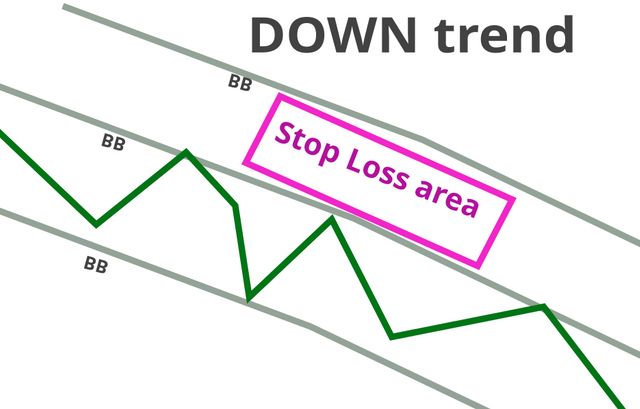
- висхідний - між середньою та нижньою лініями;
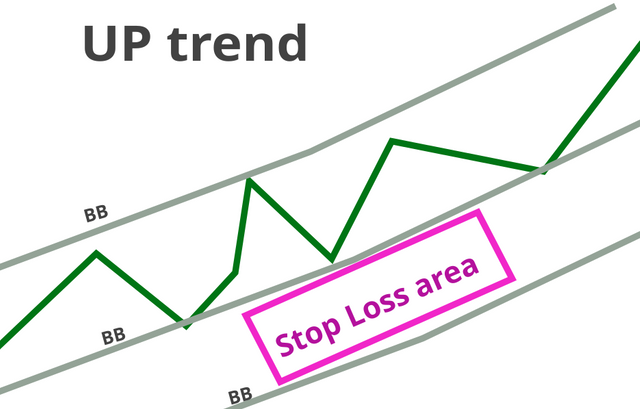
- боковий - залежно від ситуації, за верхньою або нижньою лініями Боллінджера.
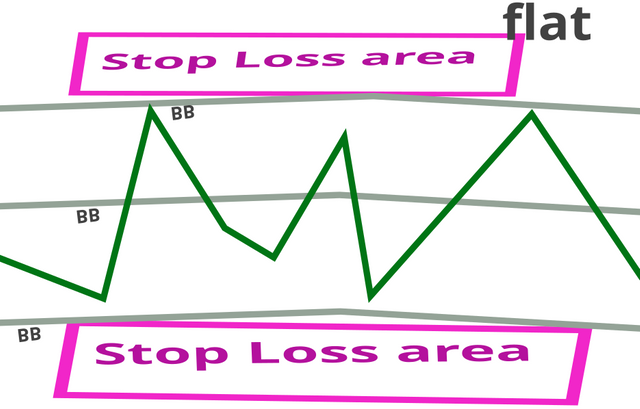
Де лінії звужуються, там стоп буде меншим, а де розширюються — більшим.
ATR
ATR відрізняється від ліній Боллінджера більшою кількістю розрахунків, бо від лінії, тобто ціни, яку вона відображає, достатньо відняти чи додати допустиму кількість пунктів для стоп-лосу. ATR має складнішу формулу й трішки більше розрахунків, проте вони можуть бути корисними:
Стоп-лосс = Ціна входу - (ATR * Коефіцієнт) // Для довгих позицій (купівлі)
Стоп-лосс = Ціна входу + (ATR * Коефіцієнт) // Для коротких позицій (продажу)
- Коефіцієнт — це те, у скільки разів буде зміщення стоп-лосу від ціни входу.
Тож залежно від волатильності допуски будуть відрізнятись, але не завжди задовольнятимуть умови мані-менеджменту, або потрібно це передбачати у стратегії.
Приклад: Стоп-лосс = 0.20 - (0.001 * 2) = 0.20 - 0.002 = 0.1980 USDT
Є один нюанс, що підхід динамічної зміни ризику відповідно до волатильності небезпечний для депозиту без кореляції розміру угоди відповідно до стоп-лосу.
| ATR | Коефіцієнт | Стоп-лосс (Ціна входу - (ATR * Коефіцієнт)) | Пункти до стоп-лоссу (0.0001) | Розмір позиції (плече 20х) | Фактична сума угоди |
|---|---|---|---|---|---|
| 0.001 | 2 | 0.20 - (0.001 * 2) = 0.19800 | 20 | 126.25 | 6.31 |
| 0.005 | 2 | 0.20 - (0.005 * 2) = 0.19000 | 100 | 25.25 | 1.26 |
| 0.01 | 2 | 0.20 - (0.01 * 2) = 0.18000 | 200 | 12.63 | 0.63 |
| 0.02 | 2 | 0.20 - (0.02 * 2) = 0.16000 | 400 | 6.31 | 0.32 |
Якщо цього не зробити, буде пропорційно зростати ризик. Ціна 0.20, коефіцієнт 2:
| ATR | 0.001 | 0.005 | 0.01 | 0.02 |
|---|---|---|---|---|
| Ризик на угоду (USD) | 1.01 USD | 5.05 USD | 10.1 USD | 20.2 USD |
Що дає менше шансів на довготривале існування капіталу.
Порівняння на графіку
Якщо поглянути на графік STEEM/USDT із доданими індикаторами ліній Боллінджера та ATR, то різниця не така й велика. Просто перший простіший, а другий вимагає більше розрахунків. Результат та рівень ризиків буде залежати від допустимих втрат на одну угоду, тож просто потрібно релевантно підбирати розмір позиції й відповідний стоп-лос. Лінії, в свою чергу, при меншому ризику як орієнтир можуть не завжди гарантувати, що стоп-лос не буде забрано. Інколи це буває. ATR, в свою чергу, залежно від застосованого коефіцієнта, може надати відповідніший рівень для стоп-лосу, враховуючи волатильність. Проте обидва індикатори при правильному розумінні поведінки ринку й динаміки будуть корисними.
Торгова стратегія для STEEM/USDT (ф'ючерс з плечем х20) із застосуванням ризиків
Стартовий капітал: 100 USDT
Ризик на одну угоду: 1% від депозиту або 1 USDT
Сума на одну угоду: 5.05 USDT
Кількість спроб: ~99
Інструменти аналізу:
- Лінії Боллінджера;
- ATR;
- Volume Profile;
- Рівні та фігури технічного аналізу - додатково.
Принцип стратегії:
Як у звичайної із такою комбінацією, але із підвищеною увагою до мані-менеджменту (ММ), який оптимізовано під динамічну зміну ринку, тобто змінюється розрахунок ризику відповідно до допусків ММ.
Покупка
2024-01-04 3:00 UTC ціна перетнула середню лінію Боллінджера знизу вгору й робить спробу закріпитись над нею. Volume Profile показує на видимій ділянці за період від 2024-12-31 лінію POC на ціні 0.2490, що має велику ймовірність продовження бичачого руху.
Розрахунок позиції:
Ціна входу: 0.2466
Варіант ризику 1: Лінії Боллінджера, стоп під середньою лінією:
- Фактична сума угоди: 5.05 (розмір 101 USDT, 405 STEEM)
- SL: 0.2446 (-0.94 USDT)
- TP: 0.2526 (+ 2.30 USDT)
- R/R = 1/3
Варіант ризику 2: ATRх2 0.2466 - (0.005 * 2) - 0.2466 = 0.1:
- Фактична сума угоди: 1.233 (розмір 24.66 USDT)
- SL: 0.2366 (-1 USDT)
- TP: 0.2766 (+3 USDT)
- R/R = 1/3.
Або високий ризик (~23 спроби):
- Фактична сума угоди: 5.05 (розмір 101 USDT)
- SL: 0.2366 (-4.1 USDT)
- TP: 0.2766 (+12.29 USDT, 12%)
- R/R = 1/3
Передбачено застосування трейлінг-стопу.
Вихід:
- TP;
- SL;
- Трейлінг Стоп;
- Ручний режим, за умови суттєвих змін.
Продаж
Принцип той же, тільки з оберненими розрахунками.
__
Висновок. Стратегія демонструє не скільки вправність та точність сигналів, скільки потрібні аспекти розрахунку ризиків.
Матеріал представлено для ознайомлення і не є прямими рекомендаціями та вказівками. Адже торгівля криптовалютою несе високі ризики для депозиту й тільки ви відповідаєте за нього, тому треба думати своєю головою.
Розбір ситуацій і наслідків
Посилаючись на першу таблицю із прикладом №1, можна без розбору реальних ситуацій зазначити, що ризик всім депозитом на одну угоду або значне перевищення загрожує швидким зникненням депозиту або скороченням його кількості на великий відсоток за один раз. А це вже не так багато шансів на примноження стартового капіталу. Якщо пощастить, то його вдасться відновити, але це час і додаткова праця без прибутку, чого можна уникнути відразу, виконуючи правильні розрахунки й дотримуючись їх, а саме:
- розумний розрахунок можливостей депозиту;
- ризик на одну угоду;
- встановлення оптимального стоп-лосу та розміру позиції відповідно до ситуації на ринку, щоб уникнути випадкового завищення ризику. Бо, по суті, коли коливання вищі, буде майже те ж саме, як при слабшому ринку;
- коли висока волатильність на ринку, то краще не торгувати, так буває навіть краще.
Орієнтовна таблиця:
| Причина збиткових угод/втрати депозиту | Приблизний відсоток |
|---|---|
| Відсутність торгової стратегії та плану | 30-40% |
| Недотримання правил мані-менеджменту | 25-35% |
| Психологічні фактори | 20-30% |
| Недостатній досвід та знання | 10-15% |
| Зовнішні фактори | 5-10% |
Подекуди психологічний аспект разом із нехтуванням мані-менеджменту може переважити багато інших. Хоча емоції здатні перекрити все інше. Тому до трейдингу найкраще підходити комплексно, змінюючи як спосіб життя, так і багато інших звичок та тренувань для психіки (дещо може бути індивідуальним). Тож найкраще робити правильні дії
від самого початку, щоб були ще й хороші професійні звички та навички.
Джерела та ресурси:
- Знімки екрана графіка STEEM з 'https://www.htx.com/trade/steem_usdt'
- Допомога та консультація із ШІ. Таблиці ним зроблені, бо по суті теж саме, що власноруч тільки довше.
- Головне зображення допису згенеровано SDXL 1.0 та відредаговано.
|ENtranslated by AI|
Proper risk assessment and management are essential components for achieving stability and long-term survival. They are important not only in financial markets but also in everyday life. The difference is that in trading, more specialized calculations and actions are required. And for this, it's worth understanding what is appropriate and beneficial under which conditions, as there are many different risks. Therefore, this topic mainly concerns the trading process, and this assumes that other security rules for the integrity of the deposit have been observed.
What is it for?
Of course, to make a profit. But with a limited amount of capital, it can be used in different ways. Since trading does not provide any guarantees, as it involves the most favorable, good, weak, or completely unsuitable conditions for opening a position. The best signals do not appear often (depending on the strategy and trading method), and their duration is not eternal. Therefore, when executing a buy or sell, there may be no profit. And it is not always possible to make a profit in one attempt because the financial weather is changeable. So, the deposit is just a certain number of attempts that can be used to make a profit until it runs out.
Example №1:
| Parameter | Spot Trading USDT | Futures Trading (20x leverage) USDT |
|---|---|---|
| Deposit | 100 | 100 |
| Trade Amount (actual) | 100 | 5.05 |
| Leverage | 1x | 20x |
| Position Size | 100 | 101 |
| Number of Attempts | 1 | ~19 |
Example #2
| Parameter | Spot Trading USDT | Futures Trading (20x leverage) USDT | |
|---|---|---|---|
| Deposit | 100 | 100 | |
| Trade Amount (actual) | 100 | 100 | |
| Leverage | 1x | 20x | |
| Price per STEEM coin | 0.20 | 0.20 | |
| Number of STEEM coins | 500 | 10,000 | |
| Position Size | 100 | 2,000 (100 * 20) | |
| Value of price step in USDT: | - | - | - |
| 0.0001 (spot) | 0.05 | 1 | |
| 0.000001 (futures) | 0.0005 | 0.01 | |
| Price change in USDT: | - | - | - |
| 0.002 | 1 | 20 | |
| 0.01 | 5 | 100 | |
| 0.05 | 25 | 500 | |
| Number of Attempts | Relevant | 1 |
The first example shows that with the same amount per trade, there will be a certain number of attempts if you are completely unlucky. In the second example, the entire deposit amount is used on futures with leverage, resulting in a larger trade size of about ten thousand STEEM coins, compared to five hundred on spot. The prospect in case of success is very tempting. One hundred points (four decimal places) is about 100 USDT. Only this is one attempt, and the permissible drawdown to the liquidation of the position is about 50-70 points. From buying at 0.20, only to 0.1950-30. Not much, and it can happen quickly. So, with such risks, this is one trade. And then what? And then, without a deposit, you can't trade anymore.
Money Management
Money management is designed to protect capital and make a profit with minimal risks. This includes several key points.
1. Position Size
A percentage or fixed value relative to the available capital. It increases the number of attempts over the long term and the chances of success by reducing and distributing risk. This is illustrated in the tables above. With the following conclusion: "A larger number of attempts, although it involves a smaller profit, ensures the stability and endurance of the deposit, considering that not all trades may be profitable. This allows for accumulating profit over a certain period with less sensitivity to price fluctuations, sometimes catching a stop-loss. Whereas overstating risks may predict a good profit but will deplete the deposit faster (possibly in one go)"
So, with 100 USDT and a position size of 5.05 on futures, there are up to 19 attempts before depletion, or a dynamic change, depending on the results. Getting a profit of 20% over several trades will increase their number.
2. Stop-Loss
| Parameter | Risk 1% of 100 USDT deposit | Risk 1 USDT of 5.05 USDT | No stop-loss (theoretically) |
|---|---|---|---|
| Stop-loss | 0.19802 USDT | 0.1999 USDT | none (liquidation ~0.19 USDT) |
| Points to stop-loss | ~20 | 1 | ~100 |
| Number of attempts | ~99 | ~1980 | ~19 |
For smaller amounts, a slightly different proportion should be applied, although 1% of the deposit is quite alright. So, 19 attempts, when setting a stop-loss of at least 20 points, gives up to 99 attempts (excluding commissions). However, it reduces volatility tolerances, so entries must be more precise. Psychologically, it is much calmer knowing that there are many attempts, making it easier to sleep.
3. Risk-Reward Ratio
The risk should be several times smaller than the profit. In short, the proportion of stop-loss to take-profit: SL/TP = 1/2, 1/3, and so on.
| Parameter | Spot (no leverage) USDT | Futures (20x leverage) USDT Risk 1% (1 of 100 USDT) | Futures (20x leverage) USDT Risk 1% |
|---|---|---|---|
| Trade Amount (actual) | 100 | 5.05 | 10 |
| Position Size | 100 | 101 | 200 |
| Stop-Loss | 0.19802 (-1 / -1%) | 0.19802 (-1/ -19.8% ) | 0.19900 (-1 / -10% ) |
| Points to Stop-Loss | ~20 | ~20 | 10 |
| TP R/R 1:1 (10 p.) | 0.20202 (+1 / +1%) | 0.20202 (+1/+19.8%) | 0.20100 (+1 USD / +10%) |
| TP R/R 1:2 (20 p.) | 0.20402 (+2 / +2%) | 0.20402 (+2/+39.6%) | 0.20200 (+2 USD / +20%) |
| TP R/R 1:3 (30 p.) | 0.20602 (+3 / +3%) | 0.20602 (+3/+59.4%) | 0.20300 (+3 USD / +30%) |
If the deposit is divided into fixed amounts for one trade to have more attempts, as is available for futures, and the risk is 1% of the total capital, then increasing the risk reduces the number of attempts and the permissible stop-loss, expressed in points. That is, on 100 USDT, with an allowable amount per trade of 5.05 USDT * 20 (leverage), it is 20 points. But, increasing the amount to 10 USDT and the risk to 1 USDT, the stop-loss will be 10 points because the value of one point increases proportionally. It seems that the number of attempts is relatively the same, but the permissible volatility range becomes even smaller. Therefore, depending on the distributed risk, the trading style will also depend or have a significant impact on the ability to stay afloat for a long time.
4. Profit Taking
Classic books may say that you need to let profits run, but it depends on the instrument and its behavior. Therefore, it is important to timely lock in a positive value if the take-profit is far away, and it was not set objectively, or the market situation changes dramatically, it is sometimes useful to close in profit because it is still a profit. Even if not as large as desired. For this, you can apply:
- Partial closing of the position - close the larger part and leave the smaller part;
- Moving the stop-loss to a positive value (above the buy point or below the sell point);
- Trailing Stop - allows you to dynamically move the stop-loss. On crypto exchanges, this works (I don't know if on all of them), even when there is no access to the terminal.
5. Loss Fixing
At a minimum, it is advisable to fix losses in two cases:
- Market changes - even with an existing stop-loss, when circumstances change significantly, waiting for the stop to trigger is not profitable;
- Without a stop-loss, which can also be the case, because there is a margin liquidation price or some other reasons that prompted trading without risk reduction. Then it can be difficult to close a losing trade, hoping for a change for the better, but it is important to do it in time because, depending on the type of trading, the entire deposit may be at risk.
6. Diversification
In general, diversification involves a smart allocation of capital among different instruments and assets. Which allows to reduce risk. Stocks, precious metals, real estate, various instruments in one category, and many other sectors. If suddenly one of them goes down, the others will help to stay afloat. In the cryptocurrency sphere, it somewhat narrows the possibilities, primarily due to the dependence on Bitcoin because often all other cryptocurrencies follow it, adding complexity to portfolio formation. However, it is possible. Even small amounts can be directed to different areas, but this will not always be trading in the classic sense.
Examples of diversification in cryptocurrencies:
- Spot trading of large cryptocurrencies (BTC, ETH)
- Spot trading of altcoins with different market capitalizations
- Futures trading with limited leverage (BTC, ETH, and other liquid assets)
- Staking
- DeFi (lending, farming, liquidity pools)
- NFT (buying, selling, collecting)
- Options trading (for experienced traders)
- Participation in IDO/ICO/IEO (investing in new projects)
- Investing in infrastructure projects (oracles, bridges, Layer 2 solutions)
- Various funds
- Shares of funds and other entities related to cryptocurrency
In short, there are plenty of places to put money, if you have it to invest. For individual management of your own portfolio with large-scale ambitions, a lot of work is needed to analyze projects, coins, and directions.
Scenario option
If narrowed down to trading, one of the scenarios could be as follows, provided well-selected assets:
- 25% - holding a package of promising coins, even during a general fall in the crypto market or pullbacks, there are occasional growth cases;
- 10% - risky IDO/ICO/IEO: sometimes ICOs do not require much at the start. If the project is good and there is an opportunity to buy some coins before the start of trading, you can make some multiples. Sometimes, a 10 USDT investment can turn into 100-1000 USDT, but this needs to be closely monitored;
- 25% - intraday futures trading with leverage. 5% for the most promising trading pairs, with good money management for each;
- 30% - staking. Also, distribute among stablecoins (stable with a small percentage) and other projects. There are places that offer a good annual percentage for placing capital in their coins and platforms, but you need to look for them, there are some decent ones;
- 10% - other directions with relevant distribution, such as NFT and much more.
7. Automation
These are various possibilities: specialized services, bots, copy trading. However, the key points there should be loss limits:
- daily;
- overall account limits;
- on the portfolio as a whole with different assets;
- trailing stop (optional).
8. Own Technological Solutions
This could include developing or training your own system using AI and Machine Learning for dynamic risk management, based on the state of the market, portfolio, positions, and all other important factors, to assist with management, or at least monitor the situation, inform, and provide advice and tips.
9. Planning and Analytical Skills
Proper planning provides clearer instructions for behavior and expectations. Analytical skills and existing knowledge help to better understand the market situation. Together, they reduce risks, as they provide more psychological resilience regarding one's actions and increase the accuracy of entries and exits.
10. Training Psychological Resilience
It's one thing to write everything down in a plan or identify behavioral cues, but another to consistently and systematically follow and execute it over a long period, which is not always possible.
In conclusion, trading should be approached comprehensively, then the result will be better.
Calculations are presented for informational purposes and do not take into account the commission for opening/closing trades and their number, which may reduce the available attempts. Also, margin requirements.
Using Volatility Indicators to Assess Risks
Considering the possibility of using Bollinger Bands and ATR, it should be noted that there are two scenarios.
First, when risks are fixed, the indicators will be additional guidelines for choosing better entry points.
Second, with dynamic changes, which leans more towards aggressive from moderate trading, as it involves increasing the stop-loss, so it should be understood that increasing the stop-loss reduces the deposit's endurance, or it is necessary to adjust the position size for a volatile market separately.
| Parameter (futures) | Calm market (example) USDT | High volatility (example) USDT |
|---|---|---|
| Trade amount (actual) | 5.05 | 2.5 |
| Leverage | 20x | 20x |
| Position size | 101 | 50 |
| Entry price | 0.20 | 0.20 |
| Stop-loss | 0.19802 | 0.19600 |
| Points to stop-loss | ~20 | ~40 |
| Allowed risk (fixed) | 1 USDT | 1 USDT |
| Loss per 1 coin at stop-loss | 0.00198 | 0.00400 |
| Number of coins | 505 | 250 |
| TP R/R 1:1 (points) | 0.20202 (20 p.) | 0.20400 (40 p.) |
| TP R/R 1:2 (points) | 0.20402 (40 p.) | 0.20800 (80 p.) |
| TP R/R 1:3 (points) | 0.20602 (60 p.) | 0.21200 (120 p.) |
Then the take-profit should also increase to meet the conditions. Therefore, before using volatility indicators, you should write down the conditions of your strategy, which provide for recalculating the position without increasing risks so that there is a larger margin for price fluctuations, or they are acceptable. Then it will be better.
Bollinger Bands
With Bollinger Bands, it's simpler, as they indicate the channel boundaries and volatility (expansion and contraction). Therefore, the approximate areas for setting a stop-loss are as follows for trends:
- downtrend - between the middle and upper lines;

- uptrend - between the middle and lower lines;

- sideways - depending on the situation, above the upper or below the lower Bollinger Bands.

Where the lines narrow, the stop will be smaller, and where they widen, it will be larger.
ATR
ATR differs from Bollinger Bands in the greater number of calculations, because from the line, i.e., the price it reflects, it is enough to subtract or add the allowable number of points for the stop-loss. ATR has a more complex formula and slightly more calculations, but they can be useful:
Stop-loss = Entry price - (ATR * Coefficient) // For long positions (buy)
Stop-loss = Entry price + (ATR * Coefficient) // For short positions (sell)
- Coefficient is how many times the stop-loss will be shifted from the entry price.
So, depending on the volatility, the allowances will differ, but they will not always meet the conditions of money management, or this needs to be provided for in the strategy.
Example: Stop-loss = 0.20 - (0.001 * 2) = 0.20 - 0.002 = 0.1980 USDT
There is one nuance that the approach of dynamically changing risk according to volatility is dangerous for the deposit without correlating the trade size according to the stop-loss.
| ATR | Coefficient | Stop-loss (Entry price - (ATR * Coefficient)) | Points to stop-loss (0.0001) | Position size (20x leverage) | Actual trade amount |
|---|---|---|---|---|---|
| 0.001 | 2 | 0.20 - (0.001 * 2) = 0.19800 | 20 | 126.25 | 6.31 |
| 0.005 | 2 | 0.20 - (0.005 * 2) = 0.19000 | 100 | 25.25 | 1.26 |
| 0.01 | 2 | 0.20 - (0.01 * 2) = 0.18000 | 200 | 12.63 | 0.63 |
| 0.02 | 2 | 0.20 - (0.02 * 2) = 0.16000 | 400 | 6.31 | 0.32 |
If this is not done, the risk will increase proportionally. Price 0.20, coefficient 2:
| ATR | 0.001 | 0.005 | 0.01 | 0.02 |
|---|---|---|---|---|
| Risk per trade (USD) | 1.01 USD | 5.05 USD | 10.1 USD | 20.2 USD |
Which gives fewer chances for long-term capital existence.
Comparison on the chart
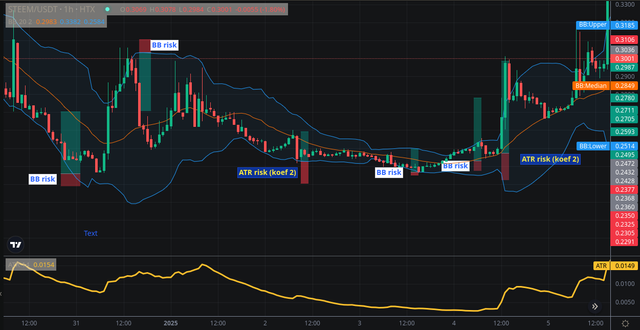
If you look at the STEEM/USDT chart with the added Bollinger Bands and ATR indicators, the difference is not that big. It's just that the former is simpler, and the latter requires more calculations. The result and the level of risks will depend on the acceptable losses per trade, so you just need to relevantly select the position size and the corresponding stop-loss. The lines, in turn, with less risk as a guideline, may not always guarantee that the stop-loss will not be taken. Sometimes it happens. ATR, in turn, depending on the applied coefficient, can provide a more appropriate level for the stop-loss, taking into account volatility. However, both indicators, with a correct understanding of market behavior and dynamics, will be useful.
Trading strategy for STEEM/USDT (futures with x20 leverage) with risk application
Starting capital: 100 USDT
Risk per trade: 1% of the deposit or 1 USDT
Amount per trade: 5.05 USDT
Number of attempts: ~99
Analysis tools:
- Bollinger Bands;
- ATR;
- Volume Profile;
- Technical analysis levels and patterns - additionally.
Strategy principle:
As with a usual strategy with such a combination, but with increased attention to money management (MM), which is optimized for dynamic market changes, that is, the risk calculation changes according to the MM allowances.
Buy
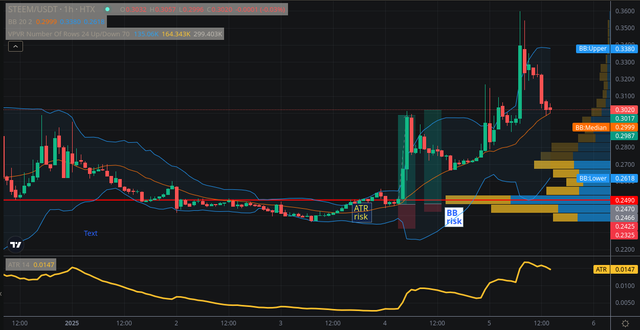
2024-01-04 3:00 UTC the price crossed the middle Bollinger Band from bottom to top and is trying to consolidate above it. The Volume Profile shows the POC line at 0.2490 in the visible area for the period from 2024-12-31, which has a high probability of continuing the bullish movement.
Position calculation:
Entry price: 0.2466
Risk option 1: Bollinger Bands, stop below the middle line:
- Actual trade amount: 5.05 (size 101 USDT, 405 STEEM)
- SL: 0.2446 (-0.94 USDT)
- TP: 0.2526 (+ 2.30 USDT)
- R/R = 1/3
Risk option 2: ATRx2 0.2466 - (0.005 * 2) - 0.2466 = 0.1:
- Actual trade amount: 1.233 (size 24.66 USDT)
- SL: 0.2366 (-1 USDT)
- TP: 0.2766 (+3 USDT)
- R/R = 1/3.
Or high risk (~23 attempts):
- Actual trade amount: 5.05 (size 101 USDT)
- SL: 0.2366 (-4.1 USDT)
- TP: 0.2766 (+12.29 USDT, 12%)
- R/R = 1/3
The use of a Trailing Stop is foreseen.
Exit:
- TP;
- SL;
- Trailing Stop;
- Manual mode, in case of significant changes.
Sell
The principle is the same, only with reversed calculations.
__
Conclusion. The strategy demonstrates not so much the skill and accuracy of signals as the necessary aspects of risk calculation.
The material is presented for informational purposes and is not direct recommendations or instructions. After all, trading cryptocurrency carries high risks for the deposit, and only you are responsible for it, so you need to think with your own head.
Analysis of situations and consequences
Referring to the first table with example №1, it can be stated without analyzing real situations that risking the entire deposit on one trade or a significant excess threatens a rapid depletion of the deposit or a reduction of its amount by a large percentage in one go. And this already leaves not so many chances to increase the starting capital. If you are lucky, it can be restored, but this is time and additional work without profit, which can be avoided immediately by making the correct calculations and adhering to them, namely:
- reasonable calculation of deposit capabilities;
- risk per trade;
- setting the optimal stop-loss and position size according to the market situation to avoid accidental over-risk. Because, in essence, when the fluctuations are higher, it will be almost the same as with a weaker market;
- when there is high volatility in the market, it is better not to trade, it is even better sometimes.
Approximate table:
| Reason for losing trades/deposit loss | Approximate percentage |
|---|---|
| Lack of trading strategy and plan | 30-40% |
| Non-compliance with money management rules | 25-35% |
| Psychological factors | 20-30% |
| Lack of experience and knowledge | 10-15% |
| External factors | 5-10% |
Sometimes the psychological aspect, along with neglecting money management, can outweigh many others. Although emotions can override everything else. Therefore, it is best to approach trading comprehensively, changing both lifestyle and many other habits and training for the psyche (some of which may be individual). So, it is best to take the correct actions from the very beginning to develop good professional habits and skills.
Sources and resources:
- Screenshots of the STEEM chart from 'https://www.htx.com/trade/steem_usdt'
- Help and consultation with AI. The tables are made by it, because in essence, it is the same as doing it manually, only longer.
#ukraine #cryptoacademy-s22w3 #club5050 #steem #moneymanagment #mm #steem #usdt #crypto #steemexclusive
Оце такої😳
Написано дуже гарно та розумно. Нещодавно хотіла подивитися як це робиться. Торгівля криптовалютами, ф'ючерси p2p. Але чесно кажучи прочитавши нічогісенько не зрозуміла 😬
Цей темний ліс не для новачків 😂
Downvoting a post can decrease pending rewards and make it less visible. Common reasons:
Submit
Слоника потрібно їсти по шматочку))
Downvoting a post can decrease pending rewards and make it less visible. Common reasons:
Submit
Ще й по маленькому шматочку 😂
Downvoting a post can decrease pending rewards and make it less visible. Common reasons:
Submit
@luxalok поклоняється Бахомет.
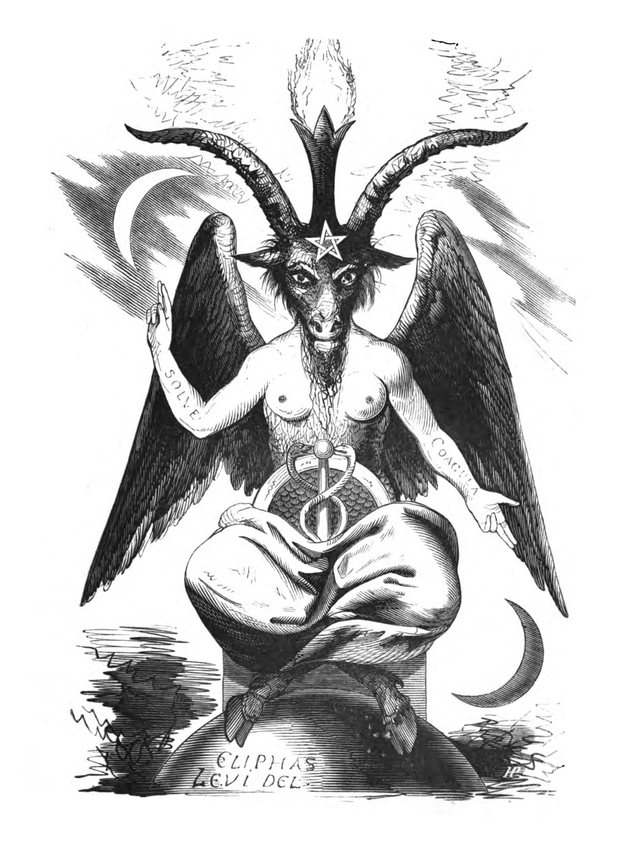
І заманює в свій егрегор людей робить з них сатаністів.
Що пьють кров молодих цнотливих жінок, приносять тварин в жертву і займаються поганими справами. Остерігайся цього тіпочка.
Downvoting a post can decrease pending rewards and make it less visible. Common reasons:
Submit
😳
Downvoting a post can decrease pending rewards and make it less visible. Common reasons:
Submit
Я серйозно. 😆
Downvoting a post can decrease pending rewards and make it less visible. Common reasons:
Submit